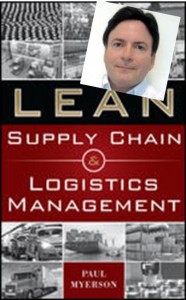Paul Myerson will be discussing his Lean Supply Chain & Logistics Simulation later in the week. This is part of a series of blog posts outlined in A Lean Service Design Approach to Gaming your Training. 
Paul was my guest on a recent Business901 Podcast, Extending Lean Supply Chain Thinking. He recently authored Lean Supply Chain and Logistics Management, a practical guide that will assist you in leveraging your improvements to both vendors and customers. Along the way, you may pick a few other Lean Tips to improve operations in general. I found it an enjoyable read and one that will find little opportunity to gather dust on my bookshelf.
This is an excerpt from the upcoming podcast:
Joe: When would you use the game for training?
Paul: Well, I find it useful whether I’m doing Lean Manufacturing for manufacturing or Lean Office for warehouse or supply chain and logistics. To be truly successful with Lean I think most people would agree that everybody has to be involved and understand that the concepts and the applications, so you always want to run as many people in your company through some kind of Lean training. The simulation is appropriate; I think, in the introductory types of setups where people might sit there and bored if they are listening to a lecture. This way, it gets them engaged. It’s a good team building approach to get them involved and see where it can really benefit them and the company and what their role in it is. So I find it to be very useful.
Joe: When you use it in a workshop setting do you use it in the introduction process or midday after you went through a few Lean principles?
Paul: Well, it’s kind of a stand-alone thing. It is basically the introductory workshop. So my particular simulation game for a supply-chain logistics has three rounds, you can use less than three if you want to make it shorter, or you can do it in two rounds. It’s typically meant to be a six to an eight-hour event that can be done shorter as I said or longer. However, it’s typically for 10 to 15 people, probably closer to 10 are better. Again, it’s kind of the introductory first-day training to get people involved and a basic understanding.
Joe: So you’re using this simulation all day long and explaining the different components?
Paul: In a nutshell, we have three rounds as I said. What we do is we start off, before we actually play the first round of the game have an introduction of Lean, just a concept of the seven ways, the non-value added, value added, all that stuff. We lay out the scenario. Again if the person who purchases the software, there’re roles to play, everybody plays a role; supply chain manager, shipper, customer service, etc. The person doing the training or the teaching might be the role of the owner of the company or a consultant brought in to teach the Lean.
The first round is kind of the as is. Here’s the situation, business runs as usual, kind of the traditional methods of push, in this case for supply chain pushing orders in waves or in batches through a warehouse for layout, large inventories, etc. at high costs.
After the first round we do some wrap up and get some people involved. We say, “OK, here’s where we are now let’s bring in this expert in Lean and talk about where we might apply Lean here.” The consultant or owner comes in and talks about some basic foundation concepts of Lean and where you might apply it in distribution and supply chain.
The second round you’ll implement some basic improvements, not dramatic but basic ones, and you’ll actually measure the end of each round. You’ll measure your profitability; your costs, inventory levels, service levels, and things like that.
Then after the second round you’ll do even more advance concepts teaching to the group, and they’ll come up with ideas for the final round, which can be pretty dramatic in terms of using vendor managed inventory, which is really just in time, dramatic one-piece flow, things like that.
By the end of the third round and the wrap up at the end dramatically increase your profitability and service levels. Talk about steps, what you might do such as value stream mapping to get into detail about the current state and how you might dramatically change it to a future state in your workplace where you might apply some of this stuff once you get out of this classroom.
That’s, in a nutshell, what the game does. It’s not a game board but people actually play the roles in the game. There are game pieces such as Lego blocks to represent inventory and a stopwatch, so it’s actually a complete game.
I followed up with questions such as:
Joe: Do you keep the same roles that people are in their work? Do you keep the roles in the game or do you have them mix it up?
Joe: As I hear you explain the game you go through, the key stages of gaming. You start as a newbie in an on boarding process and you go to more of a regular player, and then you develop it, in the gaming world they’re called an enthusiast but more of a master level. So you’re taking them through the three stages in your process?
Paul’s Lean Supply Chain & Logistics Simulation says Enna, will help your company realize its goal of becoming more Lean, more agile, and take a lead over the competition. This is a hands-on simulation that demonstrates the effectiveness of Lean in the specialized context of the Supply Chain, Logistics, and Distribution environment.

